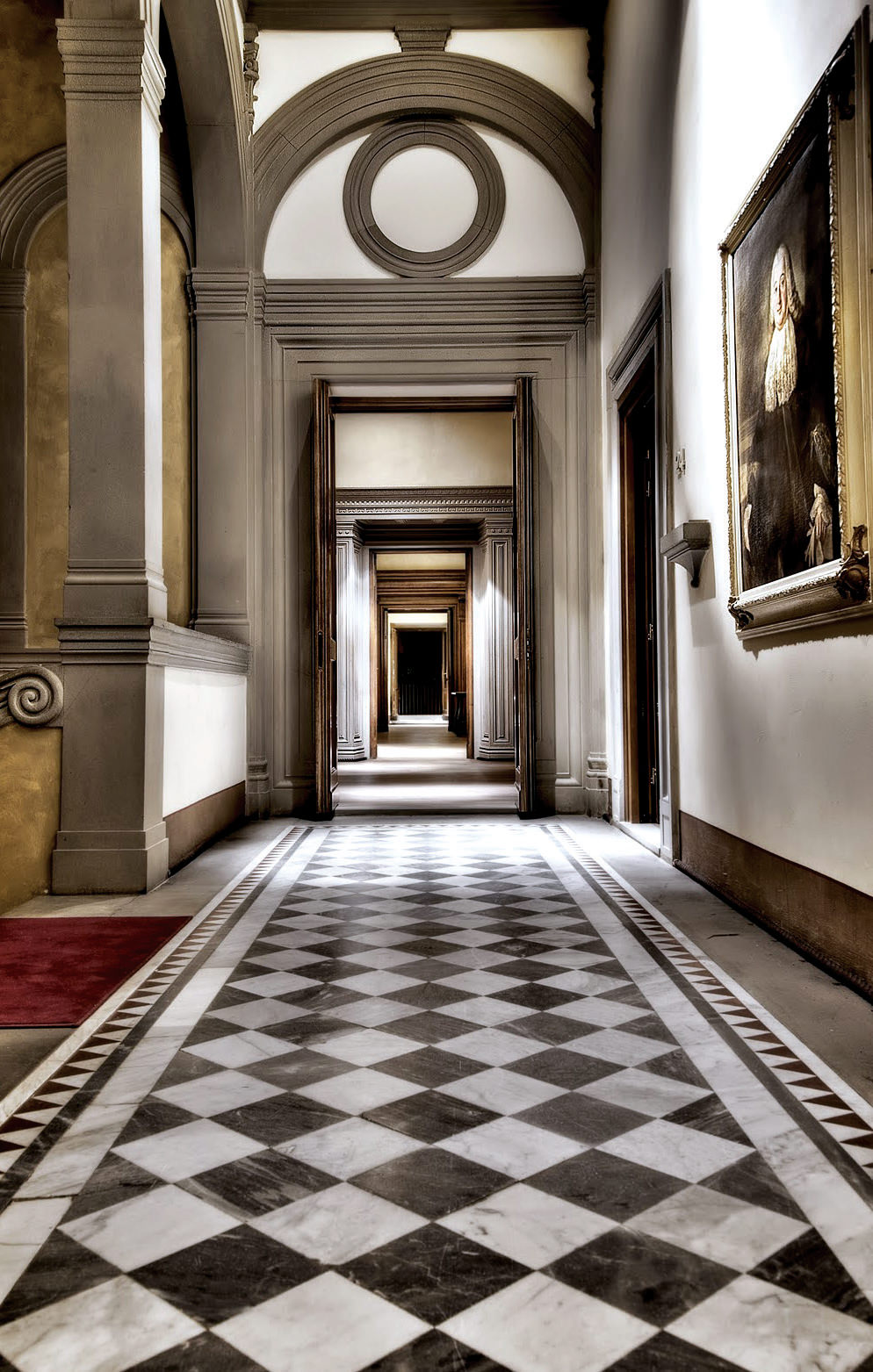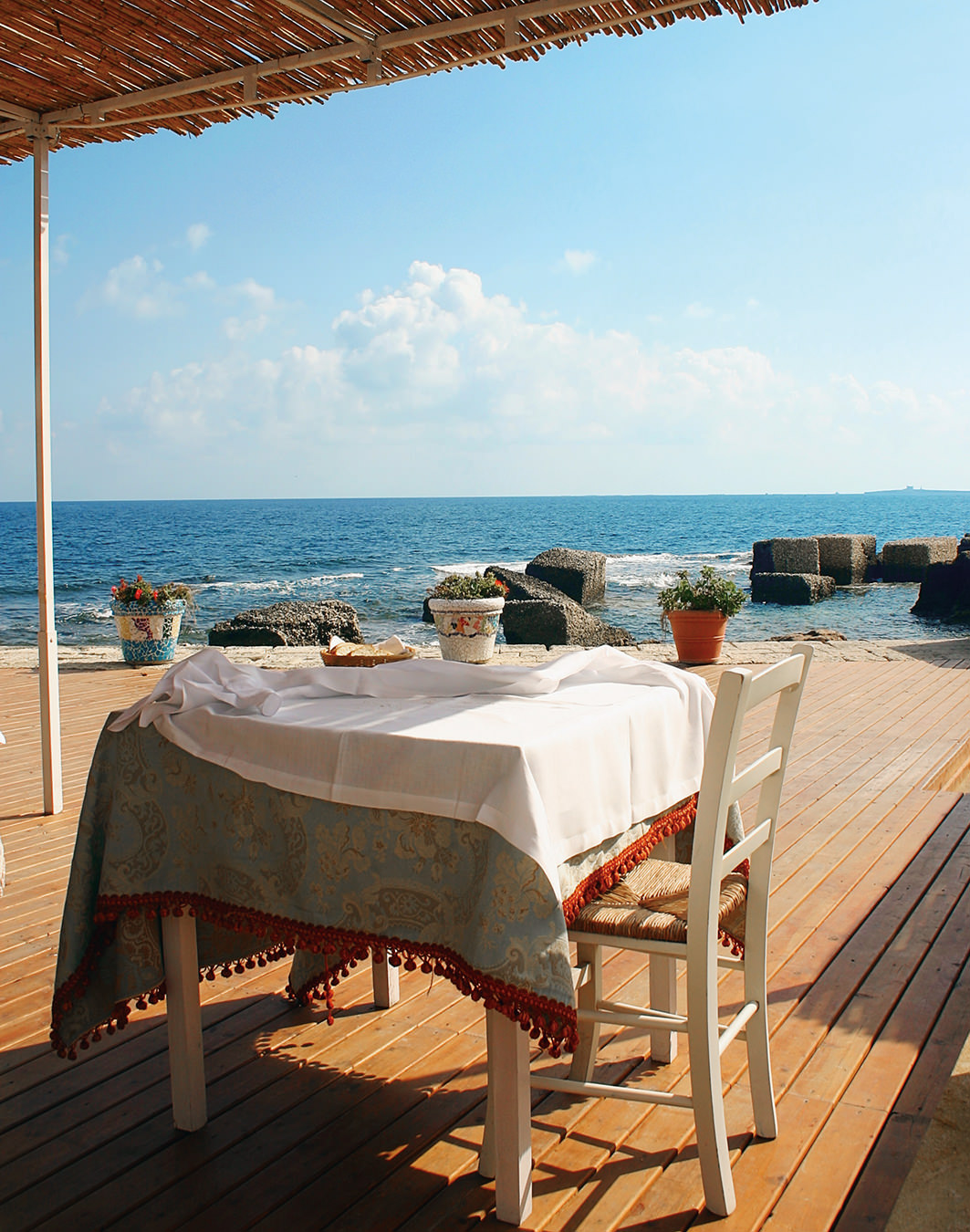-

Ornellaia’s 2015 vintage Super Tuscan.
Photo by Roberto Quagli. -

Ornellaia winery is a premier maker of Super Tuscans.
-

Preparing the grape harvest.
-

Casa Colonica on the Ornellaia estate.
-
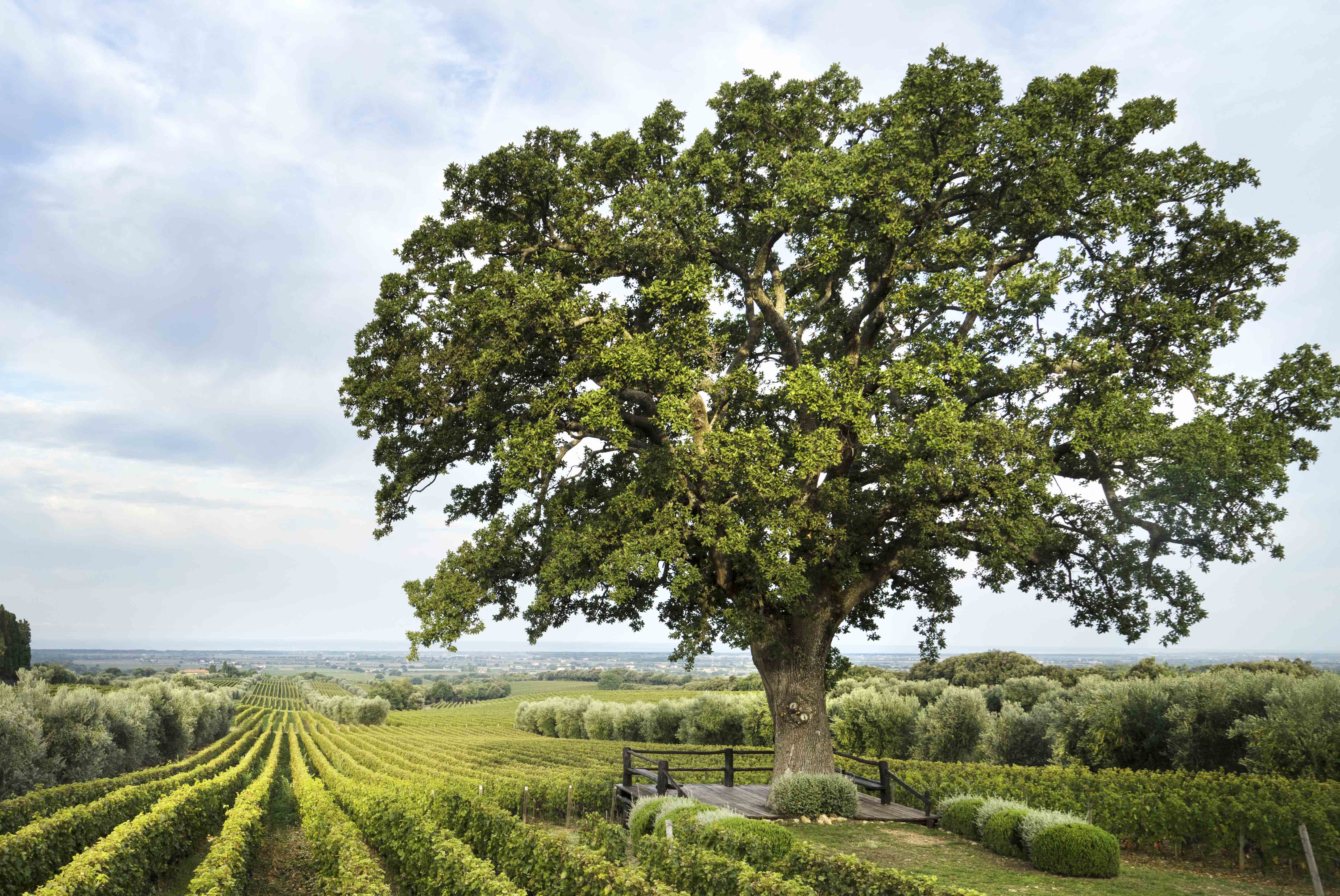
Oak of Bellaria in the Ornellaia vineyard.
Super Tuscans
The superstars that changed Italian wine.
When Super Tuscans—the best-known examples are Ornellaia, Tignanello, and Sassicaia—first appeared in the 1970s and ’80s, they were the Young Turks of the time because they challenged the major conventions of Italian wine. Rather than relying solely on indigenous grapes, especially the region’s prominent sangiovese variety, as winemakers had done for centuries, the producers of Super Tuscans turned to the so-called international varieties, notably cabernet sauvignon, merlot, and syrah. They refused to include white grapes in their red blends, even though Chianti’s wines had stood by them for more than a century. And they cocked a snoot at Italy’s wine laws, forgoing the prestigious DOC (Denominazione di Origine Controllata) classification and later the higher DOCG (DOC plus Garantita) classification, both markers of quality assurance in Italian wine-producing regions. Instead, they were content with being included in the lowly vino da tavola (table wine) category, the lowest rank under the law; the grape varieties they were using were not acceptable for the higher tiers.
The Super Tuscan producers broke all these conventions and the rest, as they say, è storia (is history). Their wines were of such good quality and were such a hit on the global wine market that they began to fetch prices well above those of other Tuscan wines. This made nonsense of Italian wine law: why were mere “table wines” selling for more than wines with the highest quality classifications? Eventually the laws were changed to give Super Tuscans the legal recognition they deserved, commensurate with their reputation. In 1992, the IGT (Indicazione Geografica Tipica) classification was created, making allowances for wines made from a wider range of grape varieties. Later, new DOCs included some of the most prestigious Super Tuscans.

Ornellaia vinyard.
But in the 1970s and ’80s, the world of wine was much different. New World regions so familiar today (South Africa, New Zealand, Australia, Chile, Argentina, and the United States) had yet to be recognized as significant producers of high-quality wines. Most European countries produced masses of mediocre wine, with quality wines coming from only a few regions, such as Bordeaux, Burgundy, Champagne, the Mosel Valley, and Rioja. Italy was best known for its wines from the Chianti region of Tuscany, but most were inexpensive, rustic but decent enough in quality, and destined for the mass market. It became popular, once the wine had been consumed, to use the straw-covered bottles (fiaschi) as candle holders.
Super Tuscans burst onto this largely drab wine scene like a dazzling display of fireworks. They came in a range of styles made from many different grape varieties; although they are often thought of as blends of the red Bordeaux grapes, there are many different combinations. Some are mostly sangiovese with contributions from cabernet sauvignon or syrah, but there are blends without sangiovese. Some of them are indeed Bordeaux blends, mainly of cabernet sauvignon and merlot, but others add the Rhone valley to the mix in the form of syrah. Some Super Tuscans are deep and brooding, others are opulent and elegant, yet others exuberant and racy. Across the board, however, they represented a general and marked improvement in quality and sophistication compared to what had been on offer.
Although Super Tuscans were widely welcomed as innovative and exciting, there was some pushback, especially in Tuscany, because they veered away from the accepted styles of the region. When the name Super Tuscan was coined in the 1980s, the reaction became that much sharper because, went the objection, these were in no sense Tuscan wines. Their greatest offence had been to reject the purity of the indigenous Tuscan grapes and embrace the heresy of the international varieties. But they had compounded the injury by showing up Italy’s other wines.
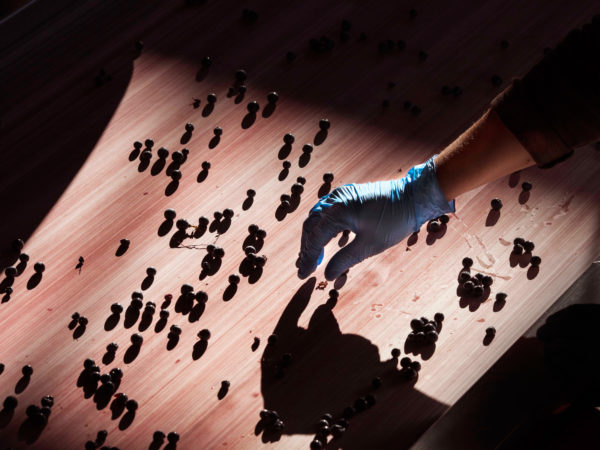
Grape selection.
How has history treated the Super Tuscans? Overall, they have gone from strength to strength, and they remain immensely popular among wine consumers and collectors. They, too, have evolved in various ways. Ornellaia, for example, started as a blend that was heavy in cabernet sauvignon: the first vintage was 80 per cent cabernet sauvignon, 15 per cent merlot, and 5 per cent cabernet franc. Since then, the percentage of cabernet sauvignon has fallen (to 53 per cent in 2015) and the proportion of other varieties has increased. And in the early 2000s, petit verdot was added to the blend. The Super Tuscan producers have also started to make wines other than the ones they have become known for. Since 1997, Ornellaia has made a second wine, Le Serre Nuove dell’Ornellaia, and makes other reds and whites as well.
In addition to the Toscana IGT classification that most Super Tuscans are labelled with, some have effectively secured their own DOC status. In 1983, DOC Bolgheri was established, named for the village of Bolgheri. With a population of less than 200, it might be small, but its global reputation is massive because the region includes the vineyards of two Super Tuscans: Ornellaia and Sassicaia. (A separate DOC for Sassicaia, Bolgheri Sassicaia, was established in 2013.) The grape varieties permitted in DOC Bolgheri red wines summarize the Super Tuscan story: they can contain cabernet franc, cabernet sauvignon, and merlot in any proportion, but sangiovese and syrah are fixed at a maximum of half the blend and other red grapes at a maximum of 30 per cent.
Ornellaia released their 2015 vintage, considered to be an almost perfect one, as part of their Vendemmia d’Artista series.
Super Tuscans, then, are no longer seen as a threat to Italian wine law but have been incorporated into it. The age of wine is not calculated like dog years, but if we were to speak in terms of wine years, we could say that Super Tuscans have evolved from their rebellious youth into a more comfortable phase. But they have lost none of their verve and appeal, and perhaps nothing shows this more clearly than the festivities surrounding the annual Vendemmia d’Artista (VdA), this year for the launch of Ornellaia’s 2015 vintage, considered to be an almost perfect one. The anniversary celebrations took place in London, where the 2015 label in the Vendemmia d’Artista series was revealed. Each year an artist is invited to design a number of labels to grace a select few bottles of Ornellaia. For the latest vintage, the artist was South African William Kentridge, whose stark and evocative charcoal images were superimposed on pages taken from 19th-century Tuscan account books.
Kentridge says the labels were inspired by a short stint harvesting grapes in Tuscany nearly 30 years ago, around the time that Ornellaia was born. His images partly pay “homage to the physical work that goes into making wine.” Kentridge designed 10 labels that appear on 111 large-format bottles and one bottle in each case of six standard bottles of Ornellaia; the label will also be replicated on all magnums and their wooden case lids.
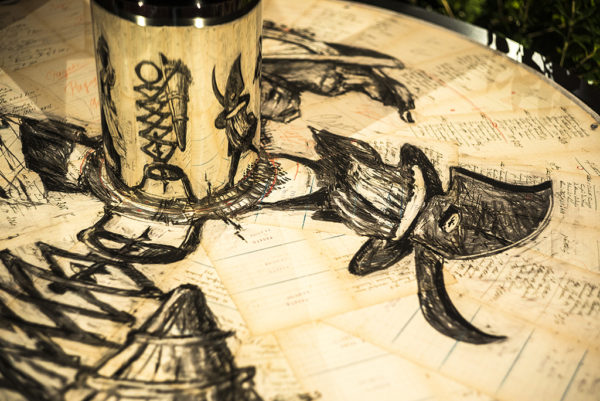
William Kentridge’s label design.
The celebration of Ornellaia 2015 peaked with a gala dinner and auction, held in a large gallery at the Victoria and Albert Museum lined with massive “cartoons” (originally commissioned for the Sistine Chapel) by Renaissance artist Raphael. The paintings recall a period when the ancestors of Ornellaia’s current owners, the Frescobaldi family, were important bankers and art patrons in Florence. The auction, run by Sotheby’s, featured special cases and large formats of Ornellaia, including double magnums (three-litre bottles) that sold for £3,500 ($6,000 Canadian) each, imperials (six-litre bottles) that sold for £7,000 ($12,000 Canadian) each, and a rare Salmanazar (nine-litre bottle) with a selling price of £50,000 ($87,000 Canadian). The proceeds of the auction went to the museum. Ornellaia holds an auction like this every vintage—in 2014 it was held at the Art Gallery of Ontario in Toronto.
Super Tuscans might well have been a bright light when they emerged into the wine world, but now they compete with many more. Fine wines are being made in many parts of the world, and the older wine-producing countries of Europe have upped their game exponentially in the last 40 or 50 years. But Super Tuscans have held their ground. They might be a category of wines rather than a consistent style, but they retain their appeal. Perhaps there’s something attractive about the way they challenged authority. They emerged at a time when conventions of all kinds—social, moral, and political—were being questioned. But these are wines that are loved because of their intrinsic quality as much as the milieu that gave rise to them.
Photos by Paolo Woods.
_________
Never miss a story. Sign up for NUVO’s weekly newsletter.

